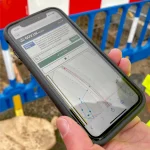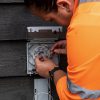UK Watchdog Proposes Tougher Rules for Advertising Broadband ISP Speeds
The Committees of Advertising Practice, which works alongside the Advertising Standards Agency to set UK Advertising Codes, has today launched a new consultation that seeks public feedback on a series of options for improving the sometimes “misleading” way in which ISPs advertise broadband speeds.
The existing guidance, which was introduced in 2012 and has seen complaints about broadband speeds drop by 60%, requires that any headline speed being promoted by an ISP must be achievable by at least 10% of their customers (i.e. the fastest 10th percentile) and these figures should be preceded by an “up to” qualifier, as well as an explanation of any limitations that may hamper the connection.
Separately Ofcom’s Code of Practice for Broadband Speed (details) also requires ISPs to give consumers, at the point of sale, an accurate estimate of the maximum speed that their line can support; this usually comes in the form of an upper and lower performance range. Speeds that fall too far below this can enable customers to exit their contract without penalty.
Advertisement
At this point the CAP correctly notes that “one-to-many advertising such as a national TV ad or outdoor billboard campaign cannot reasonably be expected to provide the same information as one-to-one information direct from each provider about the speed an individual consumer is likely to get” (i.e. today’s news focuses on one-to-many advertisements, while Ofcom’s rule covers the latter).
In short, the CAP has today proposed a series of four different options to strengthen the standards around broadband speed claims and these are open for public debate until 13th July 2017. We should add that the CAP is open to “any other options proposed by respondents, which both help to prevent consumers from being misled and better manage consumers’ expectations about the broadband speed they’re likely to receive.”
The New Options
· Peak-time median download speed;
· 24-hour national median download speed;
· Range of peak-time download speeds available to the 20th to 80th percentile of users; and
· Range of 24-hour national download speeds available to the 20th to 80th percentile of users.
NOTE: A median is the middle number (i.e. the value separating the higher half of a data sample from the lower half) and this can often be close to the traditional average (mean), although it’s not skewed so much by extremely large or small values.
The CAP states that each of the above options would also require any advert making broadband speed claims to “urge potential customers to check with the broadband provider the speed they’re likely to receive” (Ofcom’s Speed Code – see below – supports this, but only for some ISPs). However we’re disappointed to see that CAP’s announcement makes no mention of upload speeds.
How the System Works
As an example. Today a bog standard copper line based ADSL2+ broadband service (roughly half of the UK connects via one of these) can theoretically deliver a maximum download speed of 20-24Mbps but under the ASA’s current rule most of the major ISPs will instead advertise a download rate of “up to” around 17Mbps (i.e. the fastest 10%).
Advertisement
The reason for this is because service speeds, particularly those delivered via connections that require older copper lines (ADSL, VDSL2 / FTTC etc.) where the signals deteriorate over distance or can be impacted by poor home wiring and other forms of EM interference, will vary significantly between homes. Other factors like network congestion and slow WiFi may also have an impact on what you see.
By comparison if the ASA were to adopt the ‘24-hour national median download speed‘ rule, which is perhaps the easiest to communicate, then we might expect to see speeds of around 7Mbps or less being promoted for the same ADSL2+ based connection, while ‘up to’ 38Mbps FTTC options might end up advertising speeds of below 30Mbps.
Such a promotion would of course ignore the fact that many subscribers may still be able to achieve much faster performance than the median, yet at the same time it reflects that a lot of others also suffer even slower speeds. We might further expect the result for ‘peak time median download speed‘ to be a megabit or so slower than the above 24-hour figure on ADSL2+.
Finally, we have the alternative approach of offering a performance range between the speeds that the 20th to 80th percentile of subscribers to a particular package can achieve. One problem with a range like this is that some customers will still fall outside of it, which is a problem because people might be more likely to trust a range at face value (i.e. reading it as a minimum and maximum) even though that’s not what is actually being proposed.
Advertisement
At this point it becomes harder to know how “ultrafast” cable operators (e.g. Virgin Media) and pure fibre optic (FTTH/P) providers might be impacted. At ultrafast speeds the available data (e.g. public speedtests) quickly become polluted by slow WiFi and older LAN standards (e.g. wired to a 100Mbps LAN port on a 1Gbps broadband connection).
Now a quick poll..
[poll id=”12″]
NOTE: ISPs currently set their speed promotions by using their own internal data on individual connection performance rather than third-party speedtests, although Ofcom and the 2017 Digital Economy Act may shortly require them to share this information (here). Our above guesstimates for ADSL2+ and entry-level FTTC are based on public testing data and so may be more pessimistic than ISPs (i.e. take with a pinch of salt).
The Impact
Sadly Ofcom’s speed code is voluntary (many smaller ISPs have shunned it), while the ASA’s separate advertising guidance has recently come under growing pressure from politicians to be improved (here, here and here). The Government’s former Digital Economy Minister, Ed Vaizey MP, last year described the 10% approach as “misleading” and “ridiculous“; this was later echoed by a separate cross-party report.
Ed Vaizey MP said (April 2016):
“The idea that if you can deliver to 10% of houses the broadband speeds you are advertising on a large billboard and get away with it seems to be a complete and utter joke.”
Since then the ASA has conducted independent research via GfK, which surveyed a small group of consumers and found that the “current regulatory standards were likely to mislead consumers.” However the same study, which examined a wide variety of potential solutions (here), was sadly “unable to find consensus on what an alternative advertising standard should be that would ensure consumers are not being misled.”
The lack of a clear direction means that the ASA and CAP have to consult the public, which also gives ISPs a much needed chance to put their own opinions across.
Shahriar Coupal, Director of CAP, said:
“We take an evidenced-based approach to our work. Research commissioned by the ASA persuades us that tougher standards are needed to prevent consumers from being misled by advertised broadband speed claims. For the next 10 weeks, we’re inviting views on four options for change, and remain open to any other options that better manage consumers’ expectations of the broadband speed they’re likely to receive.
CAP recognises that advertising can play an early and important part in the journey to choosing a broadband provider. We’re determined to ensure the information it provides, including about broadband speed, is trusted and welcomed by consumers.”
At this point it looks like Sky Broadband’s decision in December 2016 to jump the gun and start promoting “average speeds” alongside their broadband packages (here) might have been premature. However one aspect of Sky’s decision may still hold true, depending upon which solution is ultimately adopted.
Shortly after Sky adopted “average speeds” we noted that they were no longer selling broadband (of any type) to customers with a Minimum Access Line Speed (MALS) of 2Mbps or less (here). Certainly one way to bump up your advertised rates would be to reject those on slower lines (a particular problem for rural folk where slow speeds are more common), which is perhaps not what the politicians or ASA intended.
Otherwise part of the goal here appears to be to reduce confusion, which might perhaps lend itself to selecting the simplest approach from the four options (e.g. 24-hour national median download speed). Mind you it’s surprising how many people aren’t natively familiar with standard terms like “median” and so even that has its flaws.
In the end this is less about delivering greater accuracy and more “intended to better manage consumers’ expectations,” while at the same time perhaps enabling Government politicians to secure some positive media spin before next month’s 2017 General Election.
Till Sommer, UK ISPA Policy Lead, said:
“The consultation marks a welcome shift to the current standards for broadband speed advertising which ISPA feels no longer deliver for consumers and our members.
The consultation comes at a time where, together with the relevant regulators, ISPs are actively developing and improving broadband speed and pricing information. We particularly support CAP’s suggestions that adverts should prompt consumers to ask providers for a more personalised speed estimate. Our members already provide this kind of information as part of their sales journey and we would also urge consumers to consider other factors such as brand, service quality, speed and the availability of bundled services when choosing their providers.
The consultation correctly recognises that broadband speeds depend on several factors, many of which are outside of a provider’s control, including in-home wiring and end-user devices. Accordingly, CAP are right to highlight the challenge of devising standards for one-to-many advertising that reflect the technical complexities of delivering broadband services, while also providing consumers with an accurate level of information.
Of the four options outlined by CAP, we believe that proposals that would require the inclusion of a speed range are very likely to be confusing to consumers, particularly if combined with a percentile-based user rate. We will now be working closely with our members to study the alternative options in detail and to ensure that the new broadband advertising standards provide consumers with a clear expectation of the speeds they are likely to receive, while also supporting the growth and development of the already very competitive and dynamic broadband market in the UK.”
We should point out that Ofcom will soon (Summer 2017) launch a new consultation that seeks to refresh their aforementioned code of practice, such as by updating the required personal speed estimates to reflect the impact of contention and ensuring that customers have better information about their right to exit a contract.
UPDATE 10:02am
Now a comment from Hyperoptic, which specialises in ultrafast urban fibre optic (FTTP/H/B) broadband networks.
Steve Holford, Chief Customer Officer of Hyperoptic, said:
“For too long broadband providers have been allowed to get away with misleading customers and there has been an ongoing gap between the experience advertised and that actually delivered. Advertising services based on ‘up to’ speeds has largely been meaningless. It has meant that in practice the consumer has no idea what speed they will actually get until they have signed a contract by which time they are locked in to an inadequate service for at least 18 months. The ASA consultation is therefore a step in the right direction and will force much needed clarity on the industry, which should result in a shake-up of standards and the way broadband is marketed.
We do however urge some caution. How speeds are measured is key – service providers can only dictate the speed to the home, if the speeds are measured by speed tests by the consumer, the technology and local interference (i.e. slow devices or laptops, single band routers or wifi signal interference) will all show an artificially lower speed than is actually delivered.
We also hope that the finalised guidelines from the ASA will force broadband providers to make clear exactly what service they are offering – there is a vast difference between ‘full fibre’ to the premises and ‘part fibre’ to the cabinet which still depends on copper phone wire (some of which is 140 years old) for the last part of the journey. Full fibre will nearly always match advertised speed to actual connection speed provided to the home, whereas part fibre is distance dependent, unreliable and is today limited by a technical capabilities.
Making the distinction between full and part fibre will give consumers clarity and equally importantly will help stimulate investment, which is at the heart of the Government agenda to increase full fibre way beyond the paltry 2% it is today – the lowest in the OECD.”
Mark is a professional technology writer, IT consultant and computer engineer from Dorset (England), he also founded ISPreview in 1999 and enjoys analysing the latest telecoms and broadband developments. Find me on X (Twitter), Mastodon, Facebook, BlueSky, Threads.net and Linkedin.
« SNP and Labour Criticise UK Gov Failure to Support a 30Mbps Broadband USO

















































Comments are closed